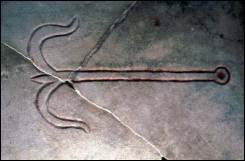In the superb Martin Gayford biography on Michelangelo (Fig Tree Press, 2013), there is a thought-provoking quote from Giorgio Vasari. Writing in 1568, he wrote, "All artists ar under a great and permanent obligation to Michelangelo, seeing that he broke the bonds and chains that had previously confined them to the creation of traditional forms."
I found this an interesting thought, because in today's context, artists probably consider Michelangelo as very traditional compared to the art and architecture often created now. Nonetheless, just as Cézanne is considered a pioneer of modern art, perhaps it is salutary to think of Michelangelo leading the way to today's wide-ranging possibilities of self-expression in art.
Vasari was in fact talking of work that Michelangelo had done 25 years previously, after he had already pushed out artistic boundaries hugely when painting the Sistine Chapel. With the Medici Pope Clement VII elected in 1523, financing on the work for the Medici funerary chapel at San Lorenzo was released, Since there had been a hiatus since Michelangelo conceived the first architectural forms in 1520-21, he had evolved and the later way he designed the tombs and surrounding elements was totally different and revolutionary.
As Martin Gayford wrote about the "breakthrough": "in the windows in the third storey of the interior of the sacristy" which "contain, in embryo, the potential of not just one future style, but two. In their wilful, witty breaking of the classical rules is the essence of Mannerist architecture. Beyond that, the lead towards the Baroque of a century later." In essence, Michelangelo had created window sides that are at an oblique, dynamic angle.
It is an interesting thought that long, long before the Cubists, the later 20th century architectures like Frank Gehry or any of the other "daring" idioms of the modern art world, Michelangelo dared to do the pretty-well-unthinkable in painting, sculpture and architecture. it just goes to show that we all need to dare, to adventure, to think independently in our creations. Boundaries are there to be crossed, limits transcended, risks embraced. Like that, just as Michelangelo did in his determined, meticulous attention to every detail of art-making, each artist can aspire to "break the bonds and chains" though serious effort and trust in that little inner voice.















